CHEVROLET TRACKER 1993 Repair Manual
Manufacturer: CHEVROLET, Model Year: 1993, Model line: TRACKER, Model: CHEVROLET TRACKER 1993Pages: 339, PDF Size: 15.75 MB
Page 61 of 339
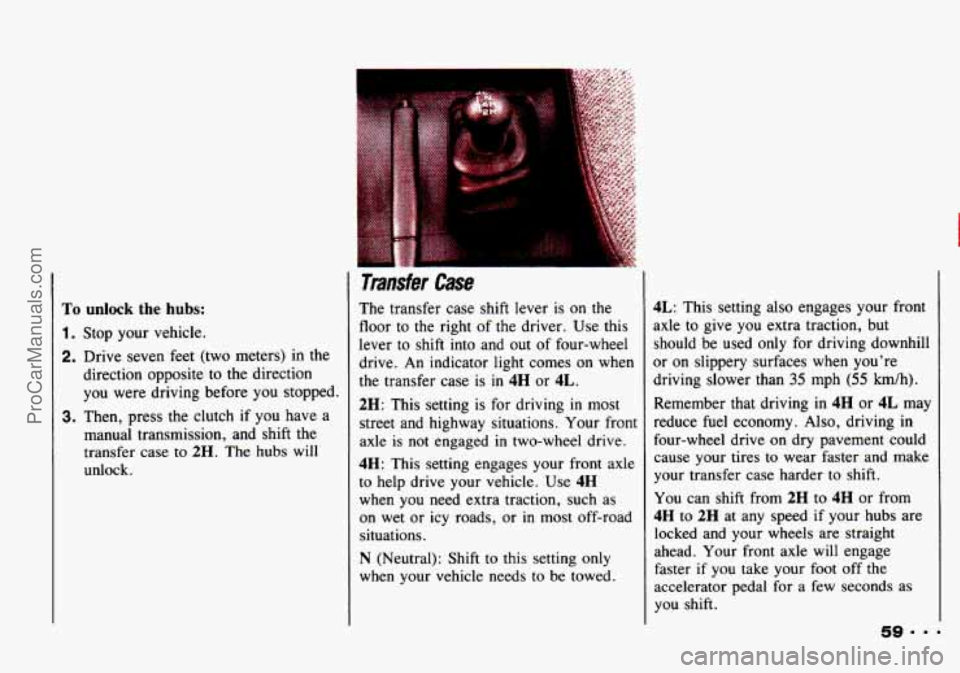
To unlock the hubs:
1. Stop your vehicle.
2. Drive seven feet (two meters) in the
direction opposite to the direction
you were driving before you stopped.
3. Then, press the clutch if you have a
manual transmission, and shift the
transfer
case to 2H. The hubs will
unlock.
Transfer Case
The transfer case shift lever is on the
floor to the right of the driver. Use this
lever to shift into and out of four-wheel
drive. An indicator light comes on when
the transfer case is in
4H or 4L.
2H: This setting is for driving in most
street and highway situations. Your front
axle
is not engaged in two-wheel drive.
4H: This setting engages your front axle
to help drive your vehicle. Use
4H
when you need extra traction, such as
on wet or icy roads,
or in most off-road
situations.
N (Neutral): Shift to this setting only
when your vehicle needs
to be towed.
4L: This setting also engages your front
axle to give you extra traction, but
should be used only for driving downhill
or on slippery surfaces when you’re
driving slower than
35 mph (55 km/h).
Remember that driving in 4H or 4L may
reduce fuel economy. Also, driving
in
four-wheel drive on dry pavement could
cause your tires to wear faster and make
your transfer case harder to shift.
You can shift from
2H to 4H or from
4H to 2H at any speed if your hubs are
locked and your wheels are straight
ahead. Your front
axle will engage
faster if you take your foot off the
accelerator pedal for a
few seconds as
you shift.
ProCarManuals.com
Page 62 of 339
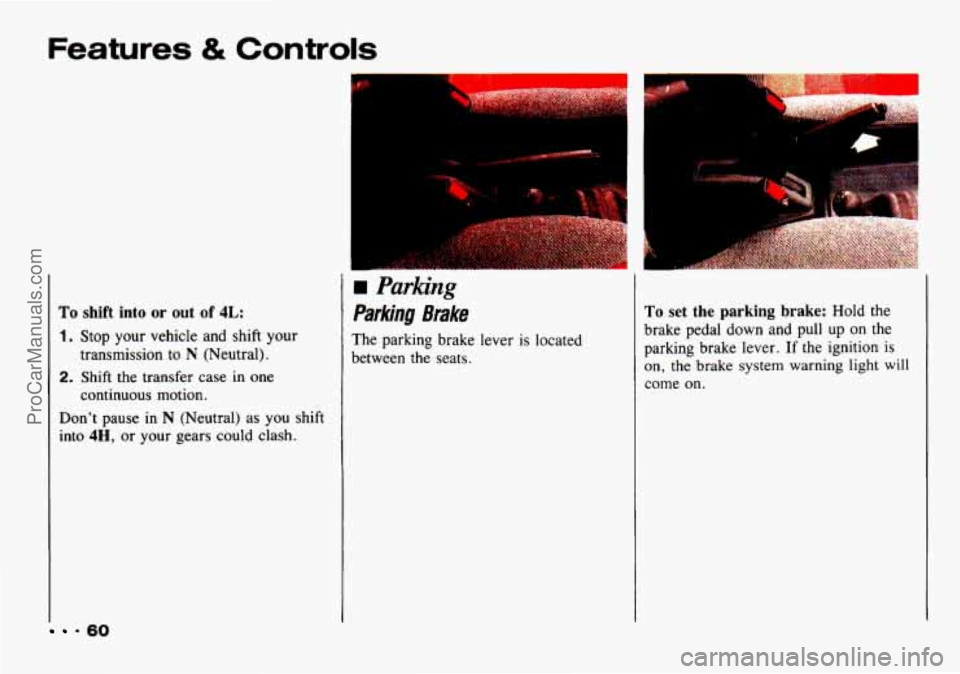
Features & Controls
900
To shift into or out of 4L:
1. Stop your vehicle and shift your
transmission to
N (Neutral).
2. Shift the transfer case in one
continuous motion.
Don't pause in
N (Neutral) as you shift
into
4H, or your gears could clash.
1.1
rn Parking
Parking Brake
The parking brake lever is located
between the seats.
'9
R :
I
To set the parking brake: Hold the
brake pedal down and pull up on the
parking brake lever.
If the ignition is
on, the brake system warning light will
come on.
ProCarManuals.com
Page 63 of 339
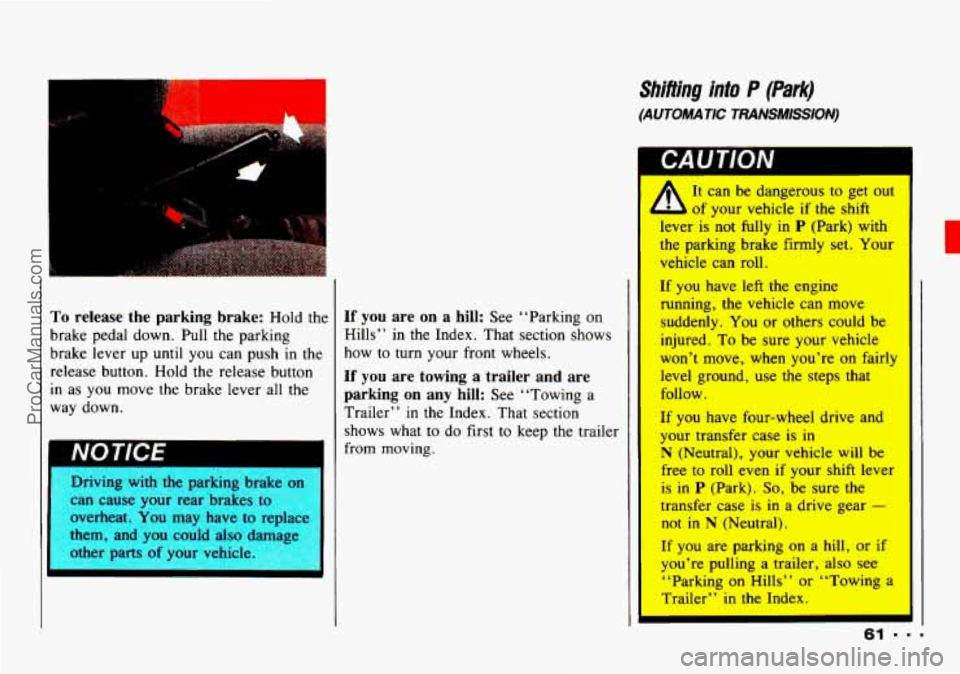
To release the parking brake: Hold the
brake pedal down. Pull the parking
brake lever up
until you can push in the
release button. Hold the release button
in as you move the brake lever all the
way down.
I NOTICE
Driving with the parking brake on
can cause your rear brakes to
overheat.
You may have to replac=
them, and
you could also dvwe
other parts
of your vehicle.
If you are on a hill: See “Parking on
Hills” in
the Index. That section shows
how to turn your front wheels.
If you are towing a trailer and are
parking on any hill:
See “Towing a
Trailer”
in the Index. That section
shows what to
do first to keep the trailer
from moving.
Shifiing into P (Park)
(AUTOMATIC TRANSMlSS/ON)
It can be dangerous to get out
of your vehicle if
the shift
lever is not fully in
P (Park) with
the parking brake firmly set. Your
vehicle can roll,
If you have left the engine
running, the vehicle can move
suddenly. You or others could be
injured. To be sure your vehicle
won’t move, when you’re on fairly
level ground, use the steps that
follow.
If you have four-wheel drive and
your transfer case
is in
N (Neutral), your vehicle will be
free
to roll even if your shift lever
is in
P (Park). So, be sure the
transfer case
is in a drive gear -
not in N (Neutral).
If
you are parking on a hill, or if
you’re pulling a trailer, also see
‘‘Parking on Hills”
or ‘‘Towing a
Trailer” in the Index.
ProCarManuals.com
Page 64 of 339
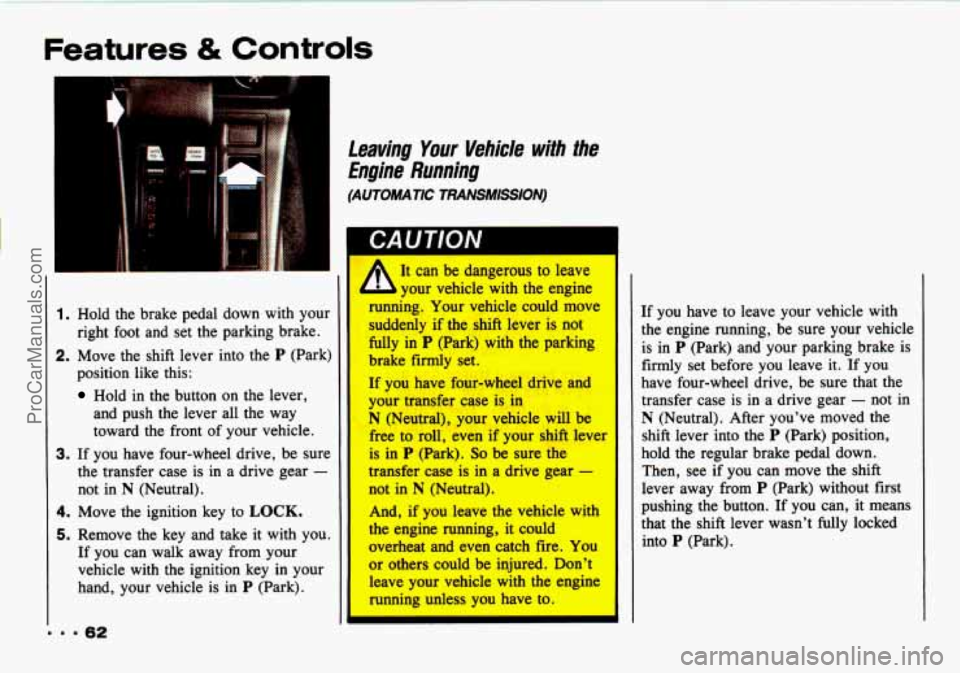
Features & Controls
1. Hold the brake pedal down with your
right foot and set the parking brake.
2. Move the shift lever into the P (Park)
position like this:
Hold in the button on the lever,
and push the lever all the way
toward the front of your vehicle.
3. If you have four-wheel drive, be sure
the transfer case is in a drive gear
-
not in N (Neutral).
4. Move the ignition key to LOCK.
5. Remove the key and take it with you.
If you can walk away from your
vehicle with the ignition key in your
hand, your vehicle is
in P (Park).
Leaving Your Vehide with the
Engine Running
(AUTOMATIC TRANSMISSION)
A It can be dangerous to leave
your vehicle with the engine
running. Your vehicle could move
suddenly if the &ifl lever is not
fully in P (Park) with the parking
brake firmly set.
If you have f0.w-wheel drive and
your -fer we is. in
N (Neutral), your vehicle will be
free to roll, even if your shift lever
is in P (Park). So be sure the
transfer case is in a drive gear -
not in N (Neutral).
And, if you leave the vehicle with
the
engine running, it could
overheat and even catch fire. You
or others could be injured. Don't
leave your vehicle with the engine
running unless you have to.
If you have to leave your vehicle with
the engine running, be sure your vehicle
is in
P (Park) and your parking brake is
firmly set before you leave
it. If you
have four-wheel drive, be sure that the
transfer case is in a drive gear
- not in
N (Neutral). After you've moved the
shift lever into the
P (Park) position,
hold the regular brake pedal down.
Then, see if you can move the shift
lever away from
P (Park) without first
pushing the button. If you can, it means
that the shift lever wasn't fully locked
into
P (Park).
ProCarManuals.com
Page 65 of 339
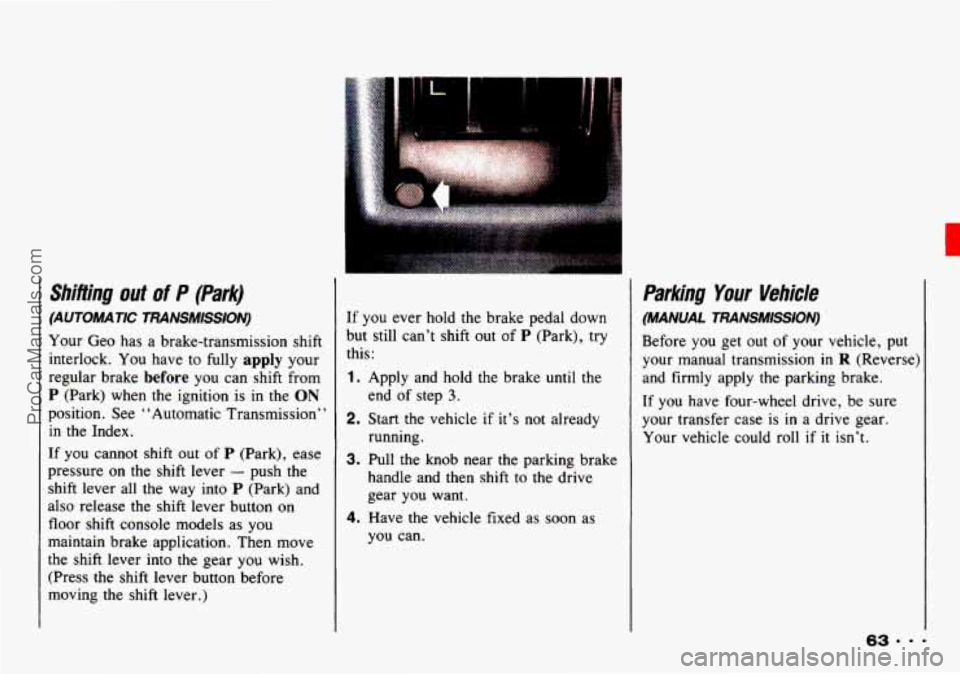
Shifling out of P (Park)
(AUTOMATIC TRANSMISSION)
Your Geo has a brake-transmission shift
interlock. You have to fully
apply your
regular brake
before you can shift from
P (Park) when the ignition is in the ON
position. See “Automatic Transmission”
in the Index.
If you cannot shift out of P (Park), ease
pressure on the shift lever
- push the
shift lever all the way into P (Park) and
also release
the shift lever button on
floor shift console models as you
maintain brake application. Then move
the shift lever into the gear you wish.
(Press
the shift lever button before
moving
the shift lever.)
I
If you ever hold the brake pedal down
but still can’t shift out of
P (Park), try
this:
1. Apply and hold the brake until the
end
of step 3.
2. Start the vehicle if it’s not already
running.
3. Pull the knob near the parking brakc
handle and then shift
to the drive
gear you want.
4. Have the vehicle fixed as soon as
you can.
Parking Your Vehicle
(MANUAL TRANSMISSION)
Before you get out of your vehicle, put
your manual transmission in
R (Reverse)
and firmly apply the parking brake.
If you have four-wheel drive, be sure
your transfer case is in a drive gear.
Your vehicle could roll
if it isn’t.
ProCarManuals.com
Page 66 of 339
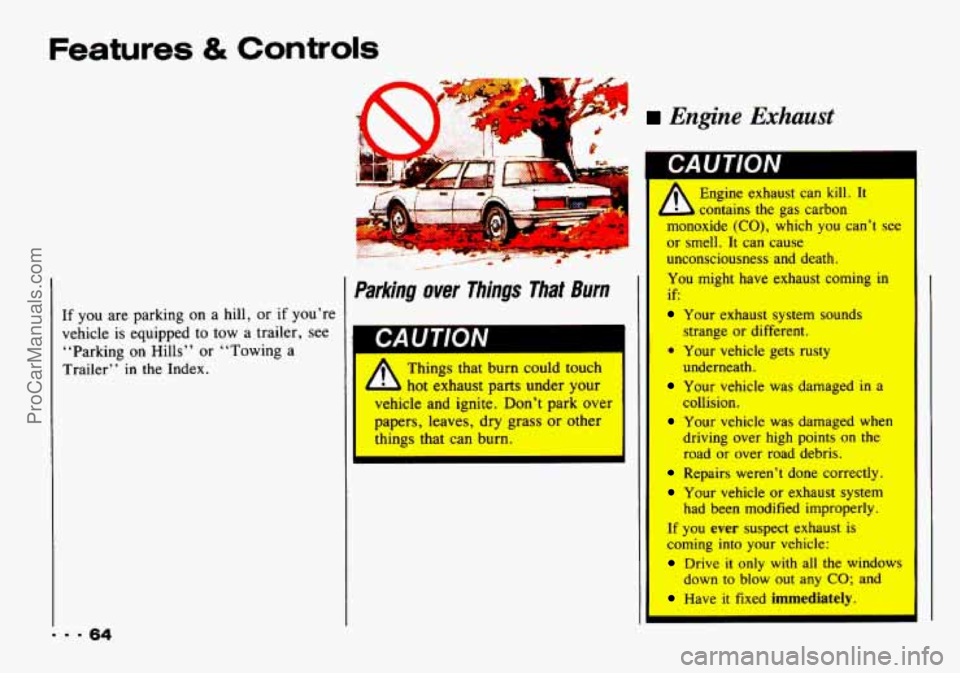
Features & Controls
If you are parking on a hill, or if you’re
vehicle
is equipped to tow a trailer, see
“Parking on Hills” or “Towing a
Trailer’
’ in the Index.
Engine Exhaust #
t
Parking over Things That Burn
uwu I IVIY
Things that burn could touch
L L hot exhaust parts under your
vehicle and ignite. Don’t park over
papers, leaves, dry grass or other
things that can burn.
A
Engine exhaust can kill. It
contains the gas carbon
monoxide
(CO), which you can’t see
or smell. It can cause
unconsciousness and death.
You might have exhaust coming
in
if:
Your exhaust system sounds
strange or different.
Your vehicle gets
rusty
underneath.
Your vehicle was damaged in a
collision.
Your vehicle was damaged when
driving over high points
on the
road or over road debris.
Repairs weren’t done correctly.
Your vehicle or exhaust system
had been modified improperly.
If you ever suspect exhaust is
coming into your
vehicle:
Drive it only with all the windows
down
to blow out any CO; and
Have it fixed immediately.
ProCarManuals.com
Page 67 of 339
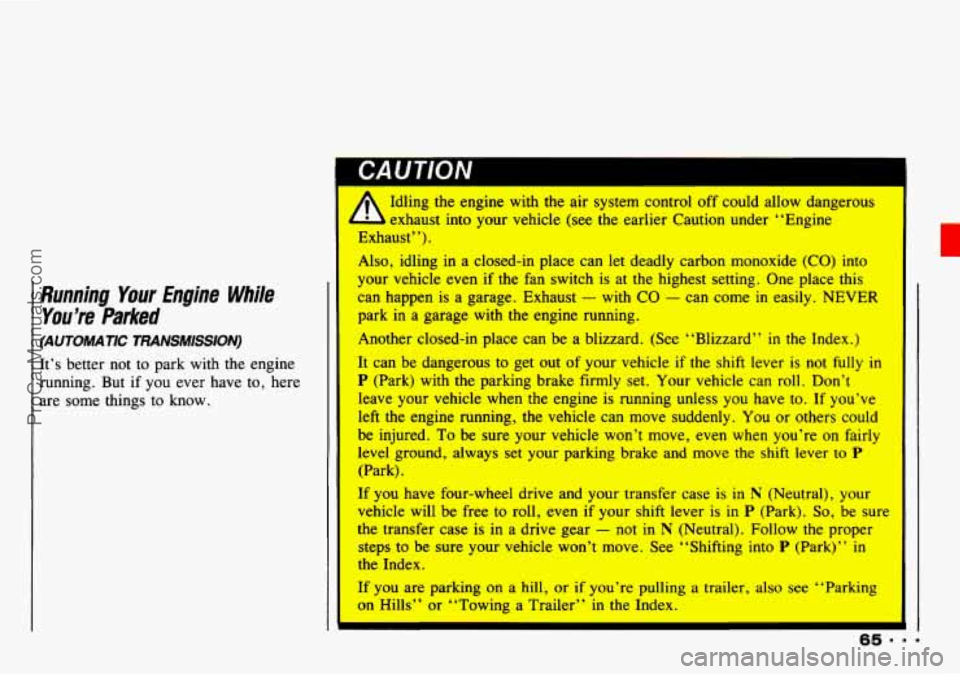
Running Your Engine While
You’re Parked
(AUTOMATIC TRANSMISSION)
It’s better not to park with the engine
running. But if
you ever have to, here
are some things to
know.
CAUTION
A
Idling the engine with the air system control off could allow dangerous
exhaust into your vehicle (see
the earlier Caution under “Engine
Exhaust’
’).
Also, idling in a closed-in place can let deadly carbon monoxide (CO) into
your vehicle even if
the fan switch is at the highest setting. One place this
can happen is a garage. Exhaust - with CO - can come in easily. NEVER
park in a garage with
the engine running.
Another closed-in place can be a blizzard. (See “Blizzard”
in the Index.)
It can be dangerous to get out of your vehicle if the shift lever is not
fully in
P (Park) with the parking brake firmly set. Your vehicle can roll. Don’t
leave your vehicle when
the engine is running unless you have to. If you’ve
left the engine running, the vehicle can move suddenly. You or others could
be injured.
To be sure your vehicle won’t move, even when you’re on fairly
level ground, always set your parking brake and move the shift lever
to P
(Park).
If you have four-wheel drive and your transfer case
is in N (Neutral), your
vehicle will be free to roll, even
if your shift lever is in P (Park). So, be sure
the transfer case
is in a drive gear - not in N (Neutral). Follow the proper
steps to be sure your vehicle won’t move. See “Shifting into
P (Park)” in
the Index.
If you are parking on a hill, or if you’re pulling a trailer, also see “Parking
on Hills” or “Towing a Trailer” in the Index.
c
ProCarManuals.com
Page 68 of 339
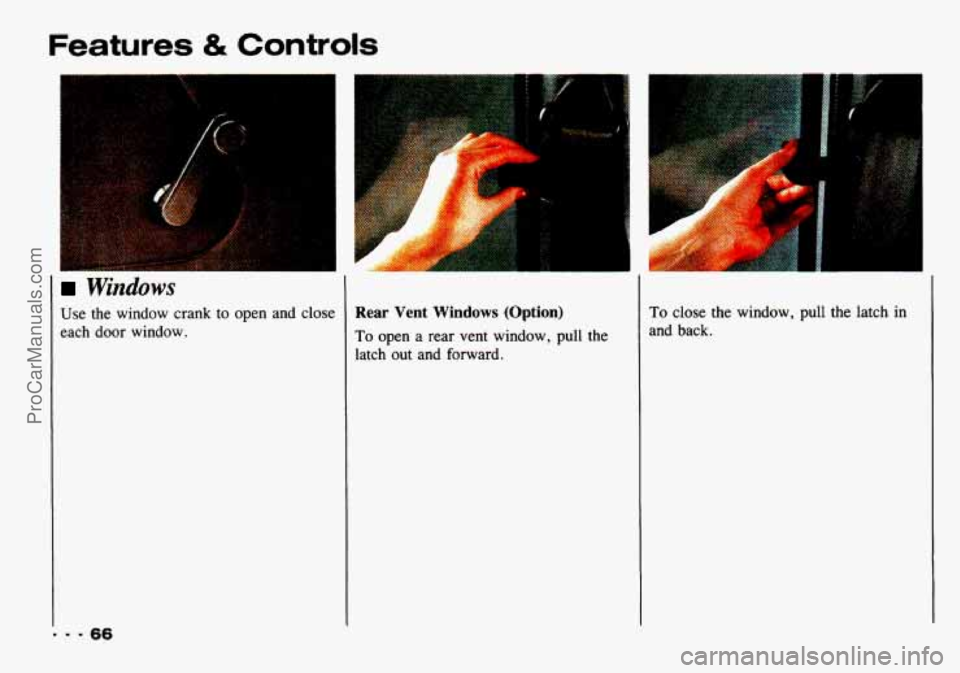
Features & Controls
..
..
..
Windows
Use the window crank to open and close
each door window. Rear Vent Windows (Option)
To open a rear vent window, pull the
latch out and forward.
To close the window, pull the latch in
and back.
ProCarManuals.com
Page 69 of 339

H Horn
To sound the horn, press the horn
symbol on your steering wheel.
I Tilt meel (OPTION)
1 tilt steerng wheel allows you to adjust
he steering wheel before you drive.
lou can also raise it to the highest level
o give your legs more room when you
:xit and enter the vehicle.
?o tilt the wheel, hold the steering
vheel and lower the lever. Move the
teering wheel
to a comfortable level,
hen raise the lever to its highest
losition to lock the wheel in place.
H I;he Turn SignaULights
CoPttrolHeadlight Beam
Lever
The lever on the left side of the steering
column includes your:
Turn Signal and Lane Change
Headlight High/Low Beam and
Indicator
Passing Signal
Lighting Operation
67
c
ProCarManuals.com
Page 70 of 339
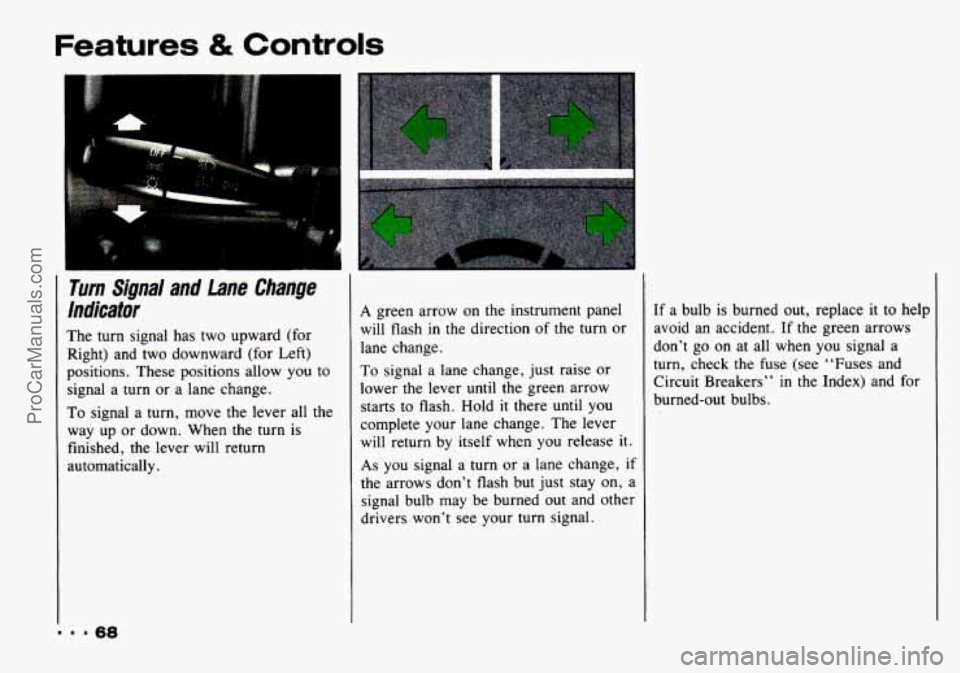
Features & Controls
Turn Signal and lane Change
lndicator
The turn signal has two upward (for
Right) and two downward (for Left)
positions. These positions allow you to
signal a turn or a lane change.
To signal a turn, move the lever all the
way
up or down. When the turn is
finished, the lever will return
automatically.
A green arrow on the instrument panel
will flash in the direction of the turn or
lane change.
To signal a lane change, just raise or
lower the lever until the green arrow
starts to flash. Hold
it there until you
complete your lane change. The lever
will return by itself when you release it.
As you signal a turn or a lane change, if
the arrows don’t flash but just stay on, a
signal bulb may be burned out and other
drivers won’t see your turn signal. If
a bulb is burned out, replace it
to help
avoid an accident. If the green arrows
don’t go on at all when you signal a
turn, check the fuse (see “Fuses and
Circuit Breakers’’
in the Index) and for
burned-out bulbs.
ProCarManuals.com